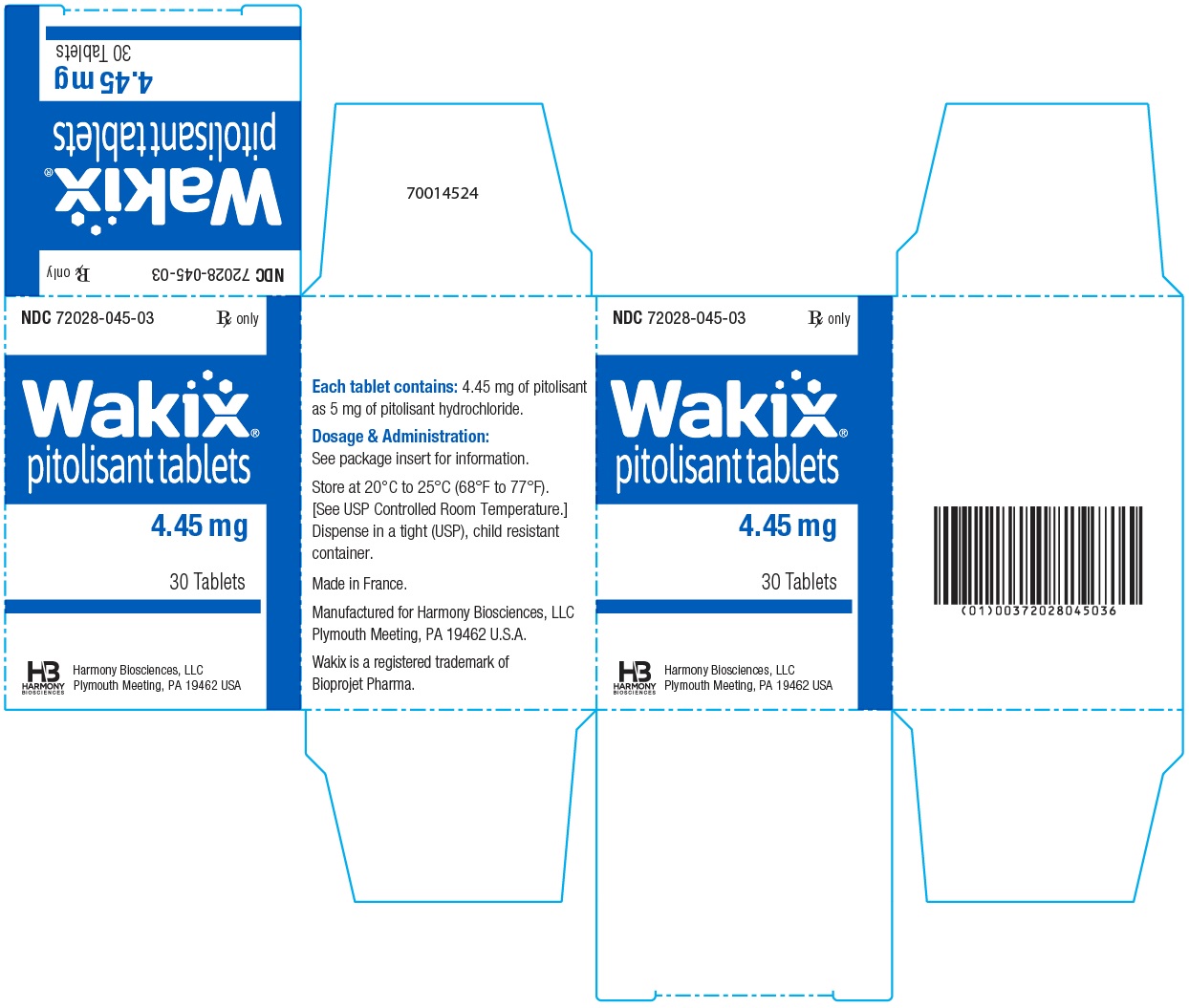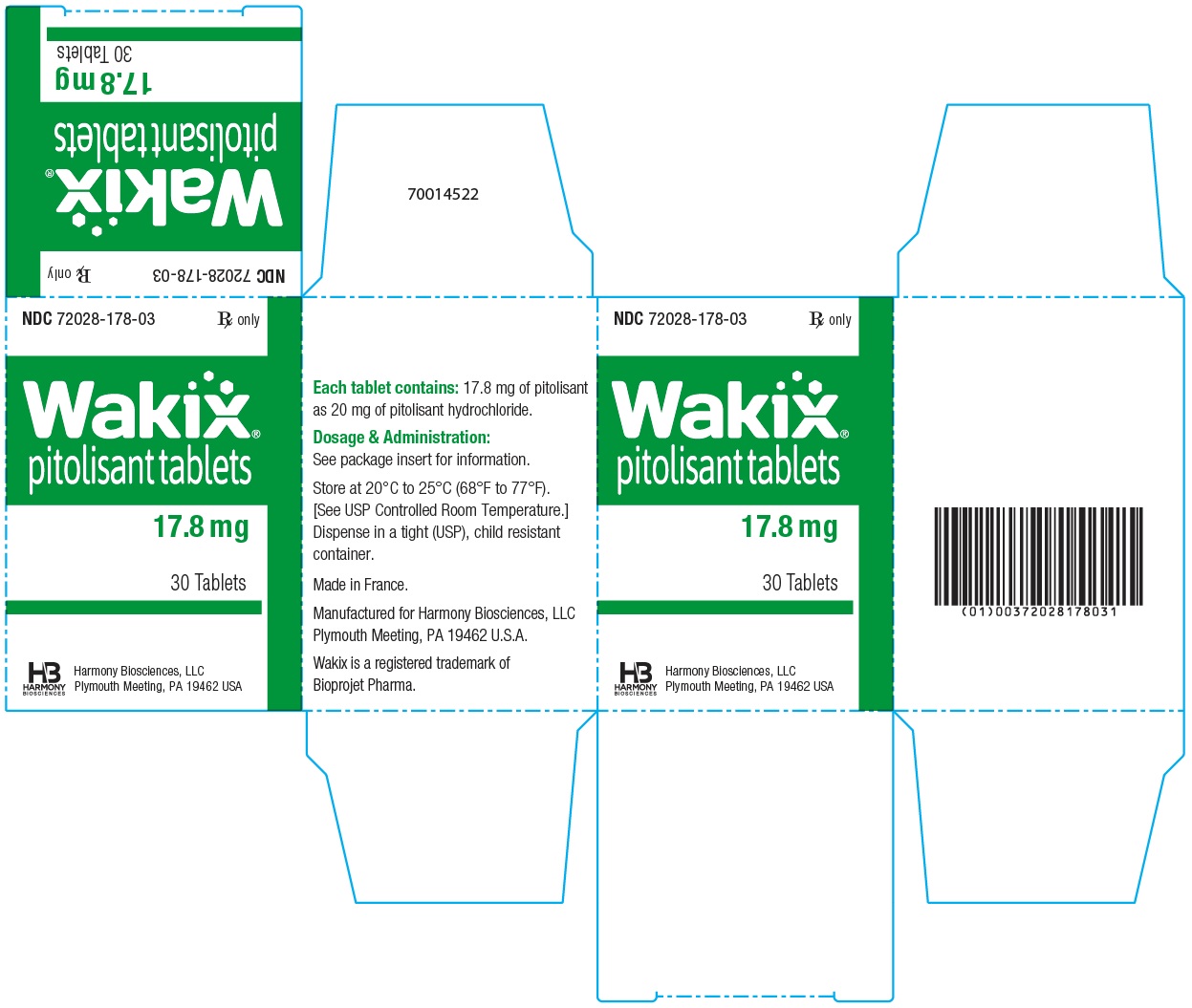WAKIX- pitolisant hydrochloride tablet, film coated
Wakix by
Drug Labeling and Warnings
Wakix by is a Prescription medication manufactured, distributed, or labeled by Harmony Biosciences, LLC. Drug facts, warnings, and ingredients follow.
Drug Details [pdf]
-
HIGHLIGHTS OF PRESCRIBING INFORMATION
These highlights do not include all the information needed to use WAKIX® safely and effectively. See full prescribing information for WAKIX.
WAKIX® (pitolisant) tablets, for oral use
Initial U.S. Approval: 2019
INDICATIONS AND USAGE
WAKIX is a histamine-3 (H3) receptor antagonist/inverse agonist indicated for the treatment of excessive daytime sleepiness (EDS) in adult patients with narcolepsy (1)
DOSAGE AND ADMINISTRATION
- Administer once daily in the morning upon wakening.
- The recommended dosage range is 17.8 mg to 35.6 mg daily. Titrate dosage as follows:
- Week 1: Initiate with 8.9 mg once daily
- Week 2: Increase dosage to 17.8 mg once daily
- Week 3: May increase to the maximum recommended dosage of 35.6 mg once daily (2.1)
- Hepatic impairment (2.2, 8.6, 12.3):
- Moderate hepatic impairment: Initial dosage is 8.9 mg once daily. Titrate to a maximum dosage of 17.8 mg once daily after 14 days
- Renal impairment (2.3, 8.7, 12.3):
- Moderate and severe impairment: Initial dosage is 8.9 mg once daily. Titrate to maximum dosage of 17.8 mg once daily after 7 days
- End-stage renal disease (ESRD): Not recommended
- Poor Metabolizers of CYP2D6: Maximum recommended dosage is 17.8 mg once daily (2.5)
DOSAGE FORMS AND STRENGTHS
Tablets: 4.45 mg and 17.8 mg (3)
CONTRAINDICATIONS
WAKIX is contraindicated in patients with severe hepatic impairment (4)
WARNINGS AND PRECAUTIONS
QT Interval Prolongation: Increases in QT interval. Avoid use with drugs that also increase the QT interval and in patients with risk factors for prolonged QT interval. Monitor patients with hepatic or renal impairment for increased QTc (5.1)
ADVERSE REACTIONS
The most common adverse reactions (≥5% and twice placebo) for WAKIX were insomnia, nausea, and anxiety (6.1)
To report SUSPECTED ADVERSE REACTIONS, contact Harmony Biosciences at 1-800-833-7460 or FDA at 1-800-FDA-1088 or www.fda.gov/medwatch.
DRUG INTERACTIONS
- Strong CYP2D6 Inhibitors: Maximum recommended dosage is 17.8 mg once daily (2.4, 7.1)
- Strong CYP3A4 Inducers: Decreased exposure of WAKIX; consider dosage adjustment (2.4, 7.1)
- Sensitive CYP3A4 Substrates (including hormonal contraceptives): WAKIX may reduce effectiveness of sensitive CYP3A4 substrates. Use an alternative non-hormonal contraceptive method during treatment with WAKIX and for at least 21 days after discontinuation of treatment (7.1, 8.3)
See 17 for PATIENT COUNSELING INFORMATION.
Revised: 11/2019
-
Table of Contents
FULL PRESCRIBING INFORMATION: CONTENTS*
1 INDICATIONS AND USAGE
2 DOSAGE AND ADMINISTRATION
2.1 Recommended Dosage
2.2 Dosage Modification and Recommendations in Patients with Hepatic Impairment
2.3 Dosage Modification and Recommendations in Patients with Renal Impairment and End-Stage Renal Disease
2.4 Dosage Recommendations for Concomitant Use with Strong CYP2D6 Inhibitors and Strong CYP3A4 Inducers
2.5 Use in Patients Who Are Known CYP2D6 Poor Metabolizers (PMs)
3 DOSAGE FORMS AND STRENGTHS
4 CONTRAINDICATIONS
5 WARNINGS AND PRECAUTIONS
5.1 QT Interval Prolongation
6 ADVERSE REACTIONS
6.1 Clinical Trials Experience
6.2 Postmarketing Experience
7 DRUG INTERACTIONS
7.1 Drugs Having Clinically Important Interactions with WAKIX
7.2 Drugs Having No Clinically Important Interactions with WAKIX
8 USE IN SPECIFIC POPULATIONS
8.1 Pregnancy
8.2 Lactation
8.3 Females and Males of Reproductive Potential
8.4 Pediatric Use
8.5 Geriatric Use
8.6 Hepatic Impairment
8.7 Renal Impairment
8.8 CYP2D6 Poor Metabolizers
11 DESCRIPTION
12 CLINICAL PHARMACOLOGY
12.1 Mechanism of Action
12.2 Pharmacodynamics
12.3 Pharmacokinetics
12.5 Pharmacogenomics
13 NONCLINICAL TOXICOLOGY
13.1 Carcinogenesis, Mutagenesis, Impairment of Fertility
13.2 Animal Toxicology and/or Pharmacology
14 CLINICAL STUDIES
16 HOW SUPPLIED/STORAGE AND HANDLING
16.1 How Supplied
16.2 Storage and Handling
17 PATIENT COUNSELING INFORMATION
- * Sections or subsections omitted from the full prescribing information are not listed.
-
1 INDICATIONS AND USAGE
WAKIX is indicated for the treatment of excessive daytime sleepiness (EDS) in adult patients with narcolepsy [see Clinical Studies (14)].
-
2 DOSAGE AND ADMINISTRATION
2.1 Recommended Dosage
The recommended dosage range for WAKIX is 17.8 mg to 35.6 mg administered orally once daily in the morning upon wakening. Titrate dosage as follows:
Week 1: Initiate with a dosage of 8.9 mg (two 4.45 mg tablets) once daily
Week 2: Increase dosage to 17.8 mg (one 17.8 mg tablet) once daily
Week 3: May increase to the maximum recommended dosage of 35.6 mg (two 17.8 mg tablets) once daily
Dose may be adjusted based on tolerability.
If a dose is missed, patients should take the next dose the following day in the morning upon wakening.
It may take up to 8 weeks for some patients to achieve a clinical response.
2.2 Dosage Modification and Recommendations in Patients with Hepatic Impairment
In patients with moderate hepatic impairment, initiate WAKIX at 8.9 mg once daily and increase after 14 days to a maximum dosage of 17.8 mg once daily [see Warnings and Precautions (5.1), Use in Specific Populations (8.6), Clinical Pharmacology (12.3)].
WAKIX is contraindicated in patients with severe hepatic impairment. WAKIX has not been studied in patients with severe hepatic impairment [see Contraindications (4), Warnings and Precautions (5.1), Use in Specific Populations (8.6), Clinical Pharmacology (12.3)].
2.3 Dosage Modification and Recommendations in Patients with Renal Impairment and End-Stage Renal Disease
In patients with moderate and severe renal impairment, initiate WAKIX at 8.9 mg once daily and increase after 7 days to a maximum dosage of 17.8 mg once daily [see Warnings and Precautions (5.1), Use in Specific Populations (8.7), Clinical Pharmacology (12.3)].
WAKIX is not recommended in patients with end-stage renal disease (ESRD) [see Warnings and Precautions (5.1), Use in Specific Populations (8.7), Clinical Pharmacology (12.3)].
2.4 Dosage Recommendations for Concomitant Use with Strong CYP2D6 Inhibitors and Strong CYP3A4 Inducers
Coadministration with Strong CYP2D6 Inhibitors
For patients receiving strong CYP2D6 inhibitors, initiate WAKIX at 8.9 mg once daily and increase after 7 days to a maximum dosage of 17.8 mg once daily.
For patients on a stable dose of WAKIX, reduce the WAKIX dose by half upon initiating strong CYP2D6 inhibitors [see Drug Interactions (7.1), Clinical Pharmacology (12.3)].
Coadministration with Strong CYP3A4 Inducers
Concomitant use of WAKIX with strong CYP3A4 inducers decreases pitolisant exposure by 50%. Assess for loss of efficacy after initiation of a strong CYP3A4 inducer.
For patients stable on WAKIX 8.9 mg or 17.8 mg once daily, increase the dose of WAKIX to double the original daily dose (i.e., 17.8 mg or 35.6 mg, respectively) over 7 days.
If concomitant dosing of a strong CYP3A4 inducer is discontinued, decrease WAKIX dosage by half [see Drug Interactions (7.1), Clinical Pharmacology (12.3)].
-
3 DOSAGE FORMS AND STRENGTHS
- WAKIX 4.45 mg tablets: white, round, biconvex film-coated tablet, marked with “S” on one side and plain on the other side. Each tablet contains 5 mg of pitolisant hydrochloride equivalent to 4.45 mg of pitolisant.
- WAKIX 17.8 mg tablets: white, round, biconvex film-coated tablet, marked with “H” on one side and plain on the other side. Each tablet contains 20 mg of pitolisant hydrochloride equivalent to 17.8 mg of pitolisant.
-
4 CONTRAINDICATIONS
WAKIX is contraindicated in patients with severe hepatic impairment. WAKIX is extensively metabolized by the liver and there is a significant increase in WAKIX exposure in patients with moderate hepatic impairment [see Use in Specific Populations (8.6)].
-
5 WARNINGS AND PRECAUTIONS
5.1 QT Interval Prolongation
WAKIX prolongs the QT interval. The use of WAKIX should be avoided in patients with known QT prolongation or in combination with other drugs known to prolong the QT interval [see Drug Interactions (7.1)]. WAKIX should also be avoided in patients with a history of cardiac arrhythmias, as well as other circumstances that may increase the risk of the occurrence of torsade de pointes or sudden death, including symptomatic bradycardia, hypokalemia or hypomagnesemia, and the presence of congenital prolongation of the QT interval [see Clinical Pharmacology (12.2)]. The risk of QT prolongation may be greater in patients with hepatic or renal impairment due to higher concentrations of pitolisant. Monitor patients with hepatic or renal impairment for increased QTc. Dosage modification is recommended in patients with moderate hepatic impairment and moderate or severe renal impairment [see Dosage and Administration (2.2, 2.3)]. WAKIX is contraindicated in patients with severe hepatic impairment [see Contraindications (4)]. WAKIX is not recommended in patients with end-stage renal disease (ESRD) [see Dosage and Administration (2.3), Use in Specific Populations (8.7), Clinical Pharmacology (12.3)].
-
6 ADVERSE REACTIONS
The following adverse reactions are discussed in more detail in other sections of the labeling:
- QT Interval Prolongation [see Warnings and Precautions (5.1)]
6.1 Clinical Trials Experience
Because clinical trials are conducted under widely varying conditions, adverse reaction rates observed in the clinical trials of a drug cannot be directly compared to rates in the clinical trials of another drug and may not reflect the rates observed in practice.
In the clinical trials for narcolepsy, 172 patients were treated with WAKIX in placebo-controlled trials for up to 8 weeks and in open-label extension trials for up to 5 years. In trials in which WAKIX was directly compared to placebo, 6 of the 152 patients (3.9%) who received WAKIX and 4 of the 114 patients (3.5%) who received placebo discontinued because of an adverse event.
Most Common Adverse Reactions
In the placebo-controlled clinical trials conducted in patients with narcolepsy with or without cataplexy, the most common adverse reactions (occurring in ≥5% of patients and at twice the rate of placebo) with the use of WAKIX were insomnia (6%), nausea (6%), and anxiety (5%).
Table 1 presents the adverse reactions that occurred at a rate of ≥2% in patients treated with WAKIX and more frequently than in patients treated with placebo in the placebo-controlled clinical trials in narcolepsy.
Table 1: Adverse Reactions that Occurred in ≥2% of WAKIX-Treated Patients and More Frequently than in Placebo-Treated Patients in Three Placebo-controlled Narcolepsy Studies * The following terms were combined:
Abdominal pain includes: abdominal discomfort; abdominal pain; abdominal pain upper
Anxiety includes: anxiety; nervousness; stress; stress at work
Hallucinations includes: hallucination; hallucination visual; hypnagogic hallucination
Headache includes: cluster headache; headache; migraine; premenstrual headache; tension headache
Heart rate increased includes: heart rate increased; sinus tachycardia; tachycardia
Insomnia includes: initial insomnia; insomnia; middle insomnia; poor quality sleep
Musculoskeletal pain includes: arthralgia; back pain; carpal tunnel syndrome; limb discomfort; musculoskeletal pain; myalgia; neck pain; osteoarthritis; pain in extremity; sciatica
Rash includes: eczema; erythema migrans; rash; urticaria
Sleep disturbance includes: dyssomnia; sleep disorder; sleep paralysis; sleep talking
Upper respiratory infection includes: pharyngitis; rhinitis; sinusitis; upper respiratory tract infection; upper respiratory tract inflammation; viral upper respiratory tract infection
Adverse Reaction WAKIX
(n=152)
%Placebo
(n=114)
%Headache* 18 15 Insomnia* 6 2 Nausea 6 3 Upper respiratory tract infection* 5 3 Musculoskeletal pain* 5 3 Anxiety* 5 1 Heart rate increased* 3 0 Hallucinations* 3 0 Irritability 3 2 Abdominal pain* 3 1 Sleep disturbance* 3 2 Decreased appetite 3 0 Cataplexy 2 1 Dry mouth 2 1 Rash* 2 1 6.2 Postmarketing Experience
The following adverse reactions have been identified during post-approval use of WAKIX outside of the United States. Because these reactions are reported voluntarily from a population of uncertain size, it is not always possible to reliably estimate their frequency or establish a causal relationship to drug exposure:
General disorders and administration site conditions: fatigue
Investigations: weight increased
Nervous system disorders: epilepsy
Psychiatric disorders: abnormal behavior, abnormal dreams, anhedonia, bipolar disorder, depression, depressed mood, nightmare, sleep disorder, suicide attempt, suicidal ideation
Skin and subcutaneous tissue disorders: pruritus
-
7 DRUG INTERACTIONS
7.1 Drugs Having Clinically Important Interactions with WAKIX
Table 2: Clinically Significant Drug Interactions with WAKIX Effect of Other Drugs on WAKIX Strong CYP2D6 Inhibitors Clinical Implication: Concomitant administration of WAKIX with strong CYP2D6 inhibitors increases pitolisant exposure by 2.2-fold. Prevention or Management: Reduce the dose of WAKIX by half [see see Dosage and Administration (2.4), Clinical Pharmacology (12.3)]. Examples: paroxetine, fluoxetine, bupropion Strong CYP3A4 Inducers Clinical Implication: Concomitant use of WAKIX with strong CYP3A4 inducers decreases exposure of pitolisant by 50%. Prevention or Management: Assess for loss of efficacy after initiation of a strong CYP3A4 inducer. For patients stable on WAKIX 8.9 mg or 17.8 mg once daily, increase the dose of WAKIX to reach double the original daily dose (i.e., 17.8 mg or 35.6 mg, respectively) over 7 days. If concomitant dosing of a strong CYP3A4 inducer is discontinued, decrease WAKIX dosage by half [see see Dosage and Administration (2.4), Clinical Pharmacology (12.3)]. Examples: rifampin, carbamazepine, phenytoin Histamine-1 (H1) Receptor Antagonists Clinical Implication: WAKIX increases the levels of histamine in the brain; therefore, H1 receptor antagonists that cross the blood-brain barrier may reduce the effectiveness of WAKIX. Prevention or Management: Avoid centrally acting H1 receptor antagonists. Examples: pheniramine maleate, diphenhydramine, promethazine (anti-histamines) imipramine, clomipramine, mirtazapine (tri or tetracyclic antidepressants) QT Interval Prolongation Clinical Implication: Concomitant use of drugs that prolong the QT interval may add to the QT effects of WAKIX and increase the risk of cardiac arrhythmia. Prevention or Management: Avoid the use of WAKIX in combination with other drugs known to prolong the QT interval [see Warnings and Precautions (5.1)]. Examples: Class 1A antiarrhythmics: quinidine, procainamide, disopyramide;
Class 3 antiarrhythmics: amiodarone, sotalol;
Antipsychotics: ziprasidone, chlorpromazine, thioridazine;
Antibiotics: moxifloxacinEffect of WAKIX on Other Drugs Sensitive CYP3A4 Substrates Clinical Implication: WAKIX is a borderline/weak inducer of CYP3A4. Therefore, reduced effectiveness of sensitive CYP3A4 substrates may occur when used concomitantly with WAKIX [see Clinical Pharmacology (12.3)]. The effectiveness of hormonal contraceptives (e.g., ethinyl estradiol) may be reduced when used with WAKIX and effectiveness may be reduced for 21 days after discontinuation of therapy. Prevention or Management: Patients using hormonal contraception should be advised to use an alternative non-hormonal contraceptive method during treatment with WAKIX and for at least 21 days after discontinuation of treatment [see Use in Specific Populations (8.3)]. Examples: midazolam, hormonal contraceptives, cyclosporine 7.2 Drugs Having No Clinically Important Interactions with WAKIX
A clinical study was conducted to evaluate the concomitant use of WAKIX with modafinil or sodium oxybate. This study demonstrated no clinically relevant effect of modafinil or sodium oxybate on the pharmacokinetics of WAKIX and no effect of WAKIX on the pharmacokinetics of modafinil or sodium oxybate [see Clinical Pharmacology (12.3)].
A clinical study showed that strong CYP3A4 inhibitors (e.g., ketoconazole, grapefruit juice) have no effect on the pharmacokinetics of WAKIX [see Clinical Pharmacology (12.3)].
-
8 USE IN SPECIFIC POPULATIONS
8.1 Pregnancy
Pregnancy Exposure Registry
There is a pregnancy exposure registry that monitors pregnancy outcomes in women who are exposed to WAKIX during pregnancy. Patients should be encouraged to enroll in the WAKIX pregnancy registry if they become pregnant. To enroll or obtain information from the registry, patients can call 1-800-833-7460.
Risk Summary
Available case reports from clinical trials and postmarketing reports with WAKIX use in pregnant women have not determined a drug-associated risk of major birth defects, miscarriage or adverse maternal or fetal outcomes. In animal reproductive studies, administration of pitolisant during organogenesis caused maternal and embryofetal toxicity in rats and rabbits at doses ≥13 and >4 times the maximum recommended human dose (MRHD) of 35.6 mg based on mg/m2 body surface area, respectively. Oral administration of pitolisant to female rats during pregnancy and lactation adversely affected maternal and fetal health and produced developmental delay at doses ≥13 times the MRHD, based on mg/m2 body surface area and increased the incidence of major malformations at 22 times the MRHD (see Data).
The estimated background risk of major birth defects and miscarriage for the indicated population is unknown. All pregnancies have a background risk of birth defect, loss, or other adverse outcomes. In the U.S. general population, the estimated background risk of major birth defects and miscarriage in clinically recognized pregnancies is 2% to 4% and 15% to 20%, respectively.
Animal Data
Pitolisant was administered orally to pregnant rats during the period of organogenesis at doses of 30, 52, 90 and 110 mg/kg/day, which are approximately 7, 13, 22 and 27 times the MRHD, based on mg/m2 body surface area, respectively. Maternal toxicity occurred at >22 times the MRHD and included decreases in body weight, food consumption and convulsions. At these maternally toxic doses, no adverse effects on embryofetal development were noted and the no-observed-adverse-effect-level for embryofetal toxicity is 27 times the MRHD based on mg/m2 body surface area.
Pitolisant was administered intramuscularly to pregnant rabbits during the period of organogenesis at doses of 4, 8, and 16 mg/kg/day, which are approximately 2, 4 and 8 times the MRHD, based on mg/m2 body surface area, respectively. Maternal toxicity occurred at ≥4 times the MRHD and included significant body weight loss and decreased food consumption. Mortality (1 animal) and convulsions (2 animals) occurred at 8 times the MRHD. At the maternally toxic dose (8 times the MRHD), the incidence of pre-implantation loss and abortions increased with a consequent decrease in both the number of implantations and live fetuses. Pitolisant was not teratogenic at doses up to 8 times the MRHD; however, delayed skeletal development (incomplete ossification and supernumerary ribs) was observed. The no-observed-adverse-effect-level for maternal toxicity and embryofetal development is 2 and 4 times the MRHD based on mg/m2 body surface area, respectively.
Pitolisant was administered orally to pregnant rats from gestation day 7 through lactation day 20 post-partum at doses of 30, 52, and 90 mg/kg/day, which are 7, 13 and 22 times the MRHD, based on mg/m2 body surface area, respectively. Maternal toxicity included death, CNS signs including convulsions, and significant decrease in body weight and food consumption at 22 times the MRHD based on mg/m2 body surface area. At the maternally toxic dose (22 times the MRHD), fetal toxicity included stillbirths, postnatal pup mortality (due to lack of milk and/or failure to nurse), and decreased pup length and weight. A single female at the mid dose (13 times the MRHD) also failed to produce milk resulting in pup mortality. At the maternally toxic dose (22 times the MRHD), pitolisant was teratogenic causing major malformations (cleft palate, abnormal limb flexure). F1 toxicity included delay in postnatal development (decrease in body weight and length, delay in incisor eruption, and delay in testes descent), which occurred at ≥13 times the MRHD; however, there was no effect on sexual maturation or reproductive capacity of the F1 generation. The no-observed-adverse-effect-level for developmental toxicity is approximately 7 times the MRHD, based on mg/m2 body surface area.
8.2 Lactation
Risk Summary
There are no data on the presence of pitolisant in human milk, the effects on the breastfed infant, or the effect of this drug on milk production.
Pitolisant is present in the milk of lactating rats (see Data). When a drug is present in animal milk, it is likely that the drug will be present in human milk. The developmental and health benefits of breastfeeding should be considered along with the mother’s clinical need for WAKIX and any potential adverse effects on the breastfed child from WAKIX or from the underlying maternal condition.
Radiolabelled [14C]-pitolisant (30 mg/kg, free base; 8 times the MRHD based on mg/m2) was administered to female rats during lactation on day 14 post-partum. Radioactivity in milk was first measured at 0.25 hours post-administration and reached a maximum by 6 hours post-administration. The level of radioactivity tended to be higher in milk compared to plasma, ranging from approximately 1 to 3 times higher in milk than plasma from 0.25 to 6 hours post-administration.
8.3 Females and Males of Reproductive Potential
Contraception
WAKIX may reduce the effectiveness of hormonal contraceptives. Patients using hormonal contraception should be advised to use an alternative non-hormonal contraceptive method during treatment with WAKIX and for at least 21 days after discontinuing treatment [see Drug interactions (7.1), Clinical Pharmacology (12.3)].
8.4 Pediatric Use
The safety and effectiveness of WAKIX in pediatric patients have not been established.
Limited pharmacokinetic data from 24 pediatric patients with narcolepsy (ages 7 to <18 years) receiving a single dose of WAKIX suggest that pediatric patients have higher exposure to pitolisant than adults. The exposure (Cmax and AUC) of pitolisant was 2-fold higher in pediatric patients 12 to <18 years and 3-fold higher in pediatric patients 7 to <12 years compared to adults.
8.5 Geriatric Use
Limited pharmacokinetic data are available in healthy elderly subjects. A pharmacokinetic study that compared 12 elderly subjects (age 68 to 82 years) to 12 healthy adults (age 18 to 45 years) did not reveal any significant differences in drug exposure [see Clinical Pharmacology (12.3)].
Of the total number of patients with narcolepsy in clinical studies of WAKIX, 14 patients (5%) were ≥65 years old. No overall differences in safety or effectiveness were observed between these patients and younger patients in these clinical trials, but greater sensitivity of some older individuals cannot be ruled out. In general, dose selection for an elderly patient should be cautious, usually starting at the low end of the dosing range, reflecting the greater frequency of decreased hepatic, renal, and cardiac function, concomitant diseases, and other drug therapy.
8.6 Hepatic Impairment
WAKIX is contraindicated in patients with severe hepatic impairment (Child-Pugh C) as it has not been studied in this population. WAKIX is extensively metabolized by the liver and there is a significant increase in WAKIX exposure in patients with moderate hepatic impairment [see Contraindications (4), Clinical Pharmacology (12.3)].
Monitor patients with moderate hepatic impairment (Child-Pugh B) and adjust the dosage of WAKIX [see Dosage and Administration (2.2)].
Monitor patients with mild hepatic impairment (Child-Pugh A). No dosage adjustment of WAKIX is recommended in patients with mild hepatic impairment.
8.7 Renal Impairment
The pharmacokinetics of WAKIX in patients with end-stage renal disease (ESRD) (eGFR of <15 mL/minute/1.73 m2) is unknown [see Clinical Pharmacology (12.3)]. Therefore, WAKIX is not recommended in patients with ESRD [see Dosage and Administration (2.3), Warnings and Precautions (5.1)].
Dosage adjustment of WAKIX is recommended in patients with moderate (eGFR 30 to 59 mL/minute/1.73 m2) and severe (eGFR 15 to 29 mL/minute/1.73 m2) renal impairment [see Dosage and Administration (2.3)].
-
11 DESCRIPTION
WAKIX tablets contain pitolisant hydrochloride. Pitolisant is an antagonist/inverse agonist of the histamine-3 (H3) receptor. Pitolisant hydrochloride is a white or almost white crystalline powder with a molecular formula of C17H26ClNO·HCl and a molecular weight of 332.31. Pitolisant hydrochloride is soluble in water, ethanol, and methylene chloride and practically insoluble in cyclohexane. The chemical name of pitolisant hydrochloride is 1-{3-[3-(4-chlorophenyl)propoxy]propyl}piperidine, hydrochloride and its structural formula is:

The molecular formula of the pitolisant free base is C17H26ClNO and its molecular weight is 295.85.
WAKIX tablets are for oral administration and each film-coated tablet contains 5 mg or 20 mg of pitolisant hydrochloride (equivalent to 4.45 mg or 17.8 mg of pitolisant free base, respectively) and the following inactive ingredients: colloidal silicon dioxide, crospovidone, magnesium stearate, microcrystalline cellulose, polyethylene glycol, polyvinyl alcohol, talc, and titanium dioxide.
-
12 CLINICAL PHARMACOLOGY
12.1 Mechanism of Action
The mechanism of action of pitolisant in excessive daytime sleepiness (EDS) in adult patients with narcolepsy is unclear. However, its efficacy could be mediated through its activity as an antagonist/inverse agonist at histamine-3 (H3) receptors.
12.2 Pharmacodynamics
Pitolisant binds to H3 receptors with a high affinity (Ki = 1 nM) and has no appreciable binding to other histamine receptors (H1, H2, or H4 receptors; Ki ≥10 µM).
Cardiac Electrophysiology
WAKIX at the highest recommended dosage (i.e., 35.6 mg daily) led to a QTc increase of 4.2 msec. Exposures 3.8-fold higher than achieved at the highest recommended dose increase QTc 16 msec (mean) [see Warnings and Precautions (5.1)].
12.3 Pharmacokinetics
Following oral administration of pitolisant 35.6 mg once daily, the steady state Cmax and AUC are 73 ng/mL (range: 49.2 to 126 ng/mL) and 812 ng*hr/mL (range: 518 to 1468 ng*hr/mL), respectively. Pitolisant exposure (Cmax and AUC) increases proportionally with dose and steady state is reached by day 7.
Absorption
The median time to maximum plasma concentration (Tmax) of pitolisant is 3.5 hours (2 to 5 hours).
The oral absorption of WAKIX is around 90%.Food Effect
No clinically significant differences in the pharmacokinetics of pitolisant were observed following administration with a high-fat meal.
Distribution
The apparent volume of distribution of pitolisant is approximately 700 L (5 to 10 L/kg). Serum protein binding is approximately 91% to 96%. The blood to plasma ratio of pitolisant is 0.55 to 0.89.
Elimination
After a single dose of 35.6 mg, the median half-life of pitolisant is approximately 20 hours (7.5 to 24.2 hours). The apparent oral clearance (CL/F) of pitolisant is 43.9 L/hr and renal clearance accounts for <2% of the total clearance of pitolisant.
Metabolism
Pitolisant is primarily metabolized by CYP2D6 and to a lesser extent by CYP3A4; these metabolites are further metabolized or conjugated with glycine or glucuronic acid. None of these metabolites are pharmacologically active.
Excretion
After a single oral radiolabeled pitolisant 17.8 mg dose, approximately 90% of the dose was excreted in urine (<2% unchanged) and 2.3% in feces.
Specific Populations
No clinically significant differences in the pharmacokinetics of pitolisant were observed based on age (18 to 82 years old), sex, race/ethnicity (Caucasians or Blacks), or body weight (48 to 103 kg). The effects of end-stage renal disease and severe hepatic impairment on the pharmacokinetics of pitolisant are unknown.
Patients with Hepatic Impairment
Six subjects with mild hepatic impairment (Child-Pugh A), 6 subjects with moderate hepatic impairment (Child-Pugh B), and 12 healthy subjects matched for age, sex, body mass index and ethnicity received a single dose of WAKIX 17.8 mg to assess the pharmacokinetics of WAKIX in patients with hepatic impairment. Exposure of pitolisant in patients with mild or moderate hepatic impairment is summarized in Figure 1. No studies have been conducted in patients with severe hepatic impairment.
Figure 1: Effect of Hepatic Impairment on Pitolisant Pharmacokinetics
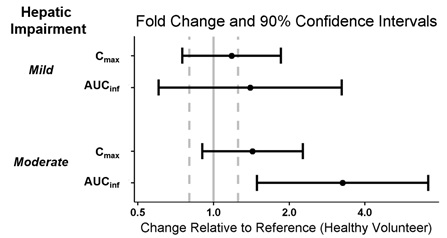
Dots = Geometric LSM ratios, Error bars = 90% CI; reference dashed lines are 0.8 and 1.25.
AUCinf = area under the curve from time 0 to time infinity; Cmax = maximum plasma concentration.
Patients with Renal Impairment
A single dose of WAKIX 17.8 mg was administered to 4 subjects with mild renal impairment (eGFR of 60 to 89 mL/min/1.73 m2), 4 subjects with moderate renal impairment (eGFR of 30 to 59 mL/min/1.73 m2), 4 subjects with severe renal impairment (eGFR of 15 to 29 mL/min/1.73 m2), and 12 subjects with normal renal function (i.e., eGFR >90 mL/min/1.73 m2) to assess the pharmacokinetics of WAKIX in patients with renal impairment. Exposure of pitolisant in patients with mild, moderate, and severe renal impairment is summarized in Figure 2. No studies have been conducted in patients with ESRD.
Figure 2: Effect of Renal Impairment on Pitolisant Pharmacokinetics
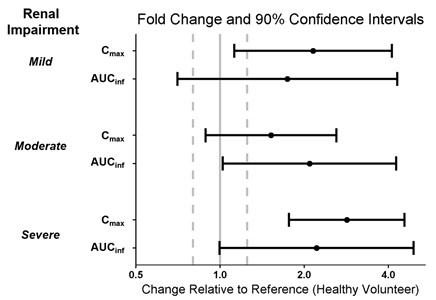
Dots = Geometric LSM ratios, Error bars = 90% CI; reference dashed lines are 0.8 and 1.25.
AUCinf = area under the curve from time 0 to time infinity; Cmax = maximum plasma concentration.
CYP2D6 Poor Metabolizers
The pharmacokinetics of pitolisant were evaluated in 3 subjects who were CYP2D6 poor metabolizers (PMs) and 5 subjects who were CYP2D6 extensive metabolizers (EMs). All subjects received WAKIX 17.8 mg daily for 7 days. Exposure of pitolisant in CYP2D6 PMs is summarized in Figure 3.
Figure 3: Pitolisant Pharmacokinetics in CYP2D6 Poor Metabolizers
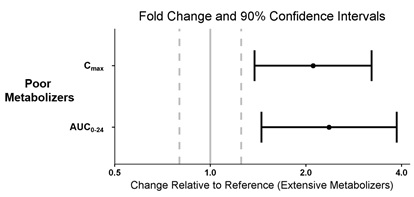
Dots = Geometric LSM ratios, Error bars = 90% CI; reference dashed lines are 0.8 and 1.25.
AUC0-24 = area under the curve from time 0 to 24 hours post-dose; Cmax = maximum plasma concentration.
Drug-Drug Interactions
Effect of Other Drugs on the Pharmacokinetics of WAKIX
The effect of other drugs on the pharmacokinetics of pitolisant is presented in Figure 4 [see Dosage and Administration (2.4), Drug Interactions (7.1)].
Figure 4: Effect of Concomitant Medications on Pitolisant
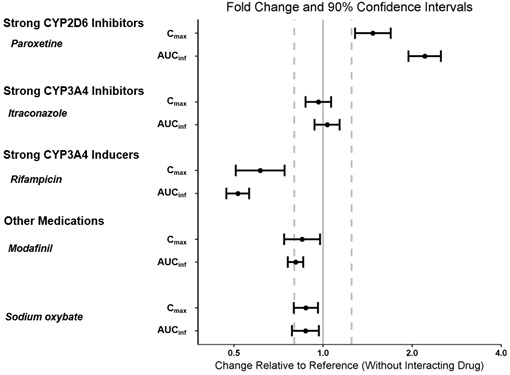
Dots = Geometric LSM ratios, Error bars = 90% CI; reference dashed lines are 0.8 and 1.25.
AUCinf = area under the curve from time 0 to time infinity; Cmax = maximum plasma concentration.
Effect of WAKIX on the Pharmacokinetics of Other Drugs
The effect of pitolisant on the pharmacokinetics of other drugs is presented in Figure 5[see Drug Interactions (7.1)].
Figure 5: Effect of Pitolisant on Concomitant Medications
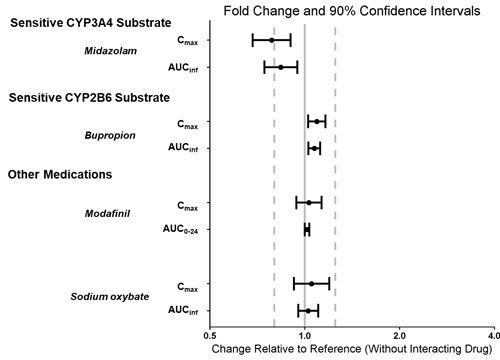
Dots = Geometric LSM ratios, Error bars = 90% CI; reference dashed lines are 0.8 and 1.25.
AUCinf = area under the curve from time 0 to time infinity; AUC0-24 = area under the curve from time 0 to 24 hours; Cmax = maximum plasma concentration.
Administration of WAKIX concomitantly with oral contraceptives may reduce their effectiveness [see Drug Interactions (7.1), Use in Specific Populations (8.3)].
12.5 Pharmacogenomics
Approximately 3 to 10% of Caucasians and 2 to 7% of African Americans generally lack the capacity to metabolize CYP2D6 substrates and are classified as poor metabolizers. The AUC of pitolisant was approximately 2.4 times higher in CYP2D6 poor metabolizers than in normal metabolizers and is similar to the exposure of pitolisant when WAKIX is administered concomitantly with a CYP2D6 inhibitor [see Dosage and Administration (2.5), Drug Interactions (7.1)].
In CYP2D6 poor metabolizers, the Cmax of pitolisant is 153 (151 to 157) ng/mL and the AUC is 1920 (1854 to 2000) ng*hr/mL after steady state dosing with 35.6 mg once daily.
-
13 NONCLINICAL TOXICOLOGY
13.1 Carcinogenesis, Mutagenesis, Impairment of Fertility
Carcinogenesis
Pitolisant was not carcinogenic in mice or rats.
Oral administration of pitolisant at 15, 30, and 75 mg/kg/day for 6 months to CB6F1 TgrasH2 transgenic mice did not increase tumor incidence. These doses are 2, 4, and 9 times the MRHD, respectively, based on mg/m2 body surface area.
Oral administration of pitolisant at 5, 15, and 30 mg/kg/day for 105 weeks to Sprague-Dawley rats did not increase tumor incidence.
Mutagenesis
Pitolisant and its metabolites were not mutagenic in the in vitro bacterial reverse mutation assay (Ames), or clastogenic in the in vitro mammalian chromosomal aberration assay. Pitolisant was negative in the in vivo mouse micronucleus assay.
Impairment of Fertility
Oral administration of pitolisant at 30, 52, and 90 mg/kg/day to male and female rats prior to and throughout mating and continuing in females through early gestation resulted in adverse effects at the mid and high doses. These doses are 13 and 22 times the MRHD, respectively, based on mg/m2 body surface area. A dose-related increase in the percentage of post-implantation loss was observed compared to controls, leading to a decrease in the percentage of live conceptuses, at doses 13 and 22 times the MRHD, based on mg/m2 body surface area. Pitolisant caused dose-related abnormalities in sperm morphology and decreased motility at doses that are 13 and 22 times the MRHD based on mg/m2 body surface area, without any significant effects on fertility indices in male rats. No effects on fertility were observed at 30 mg/kg/day (7 times the MRHD based on mg/m2 body surface area).
13.2 Animal Toxicology and/or Pharmacology
Adverse CNS-related clinical signs including tremors and convulsions occurred after single and repeated oral administration of pitolisant across multiple species. In a 9-month repeat-dose toxicity study in monkeys, sporadic incidences of convulsions occurred at doses corresponding to exposures approximately 3 times the MRHD based on Cmax and 1 times the MRHD, based on AUC. Convulsions were first observed close to Tmax and resolved by 2 hours after dosing. Convulsions were not observed after discontinuation of dosing and were not associated with microscopic findings in the brain. Safety margins at the no-observed-adverse-effect-level (NOAEL) correspond to 1 times the MRHD based on Cmax and 0.4 times based on AUC.
-
14 CLINICAL STUDIES
The efficacy of WAKIX for the treatment of excessive daytime sleepiness in adult patients with narcolepsy was evaluated in two multicenter, randomized, double-blind, placebo-controlled studies (Study 1; NCT01067222 and Study 2; NCT01638403). Patients ≥18 years of age who met the International Classification of Sleep Disorders (ICSD-2) criteria for narcolepsy and who had an Epworth Sleepiness Scale (ESS) score ≥14 were eligible to enroll in the studies. EDS was assessed using the ESS, an 8-item questionnaire by which patients rate their perceived likelihood of falling asleep during usual daily life activities. Each of the 8 items on the ESS is rated from 0 (would never doze) to 3 (high chance of dozing); the maximum score is 24. Study 1 and Study 2 included an 8-week treatment period, a 3-week dose titration phase followed by a 5-week stable dose phase. These studies compared WAKIX to both a placebo and an active control.
In Study 1, 95 patients were randomized to receive WAKIX, placebo, or active control. The dose of WAKIX was initiated at 8.9 mg once daily and could be increased at weekly intervals to 17.8 mg or 35.6 mg, based on efficacy response and tolerability. No dose adjustments were permitted during the 5-week stable dose phase. 61% of patients reached a stable dose of 35.6 mg. Median age in the study was 37 years. More than 90% of patients in the WAKIX and placebo groups were Caucasian and 54% were male. Approximately 80% of the population had a history of cataplexy.
WAKIX demonstrated statistically significantly greater improvement on the primary endpoint, the least square mean final ESS score compared to placebo (Table 3).
In Study 2, 166 patients were randomized to receive WAKIX, placebo, or active control. The dose of WAKIX was initiated at 4.45 mg and could be increased at weekly intervals to 8.9 mg or 17.8 mg, based on efficacy response and tolerability. No dose adjustments were permitted during the 5-week stable-dose phase. 76% of patients reached a stable dose of 17.8 mg. Median age in the study was 40 years. In the WAKIX and placebo groups, approximately 50% of patients were male, 90% of patients were Caucasian, and 75% of patients had a history of cataplexy.
WAKIX demonstrated statistically significantly greater improvement on the primary endpoint, the least square mean final ESS score compared to placebo (Table 3).
Examination of demographic subgroups by sex did not suggest differences in response.
The efficacy results from Study 1 and Study 2 are shown in Table 3.
Table 3: Efficacy Results for Epworth Sleepiness Scale in Patients with Narcolepsy (Study 1 and Study 2) SD = standard deviation; SE = standard error; LS Mean = least square mean; CI = confidence interval
aMaximum dose randomized to was 35.6 mg
bMaximum dose randomized to was 17.8 mg
cA lower score on the ESS represents improvement; scores range from 0 (no symptoms) to 24 (worst symptoms)
dA negative value for the placebo subtracted difference represents improvement
* Statistically significant
Study Treatment
Group (N)Baseline ESS Score
Mean (SD)Final ESS Scorec
LS Mean
at Week 8 (SE)Placebo Subtracted
Difference [95% CI]
at Week 8dStudy 1a WAKIX (n=31) 17.8 (2.5) 12.4 (1.01) -3.1* [-5.73; -0.46] Placebo (n=30) 18.9 (2.5) 15.5 (1.03) Study 2b WAKIX (n=66) 18.3 (2.4) 13.3 (1.19) -2.2* [-4.17; -0.22] Placebo (n=32) 18.2 (2.3) 15.5 (1.32) Figure 6 shows the ESS score from baseline to Week 8 in Study 1.
Figure 6: Epworth Sleepiness Scale Score (mean ± SEM) from Baseline to Week 8 in Study 1
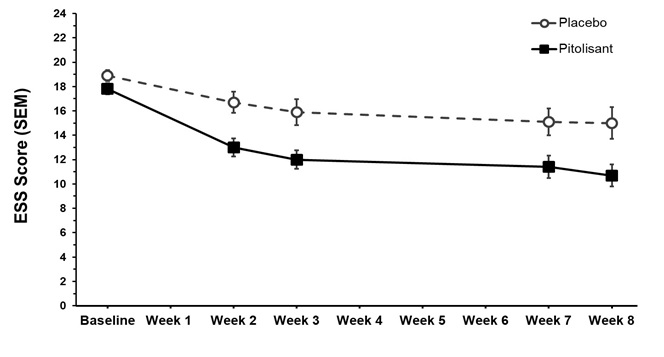
SEM = standard error of the mean (raw mean scores)
ESS scores range from 0 to 24, with 0 being the best score and 24 being the worst score -
16 HOW SUPPLIED/STORAGE AND HANDLING
16.1 How Supplied
WAKIX (pitolisant) tablets are available as:
4.45 mg: white, round, biconvex film-coated tablet, 3.7 mm diameter, marked with “S” on one side and plain on the other side.
NDC: 72028-045-03 – Bottles of 30
17.8 mg: white, round, biconvex film-coated tablet, 7.5 mm diameter, marked with “H” on one side and plain on the other side.
NDC: 72028-178-03 – Bottles of 30
-
17 PATIENT COUNSELING INFORMATION
Prolongation of the QT Interval
Inform patients to consult their physician immediately if they feel faint, lose consciousness, or have heart palpitations [see Warnings and Precautions (5.1)]. Advise patients to inform their healthcare provider that they are taking WAKIX before any new drug is taken.
Contraception
Advise patients that use of WAKIX may reduce the efficacy of hormonal contraceptives. Advise patients using a hormonal contraceptive to use an alternative non-hormonal contraceptive method of contraception during treatment and for at least 21 days after discontinuing treatment [see Drug Interactions (7.1), Use in Specific Populations (8.3)].
Pregnancy
Advise patients that there is a pregnancy exposure registry that monitors pregnancy outcomes in women exposed to WAKIX during pregnancy [see Use in Specific Populations (8.1)].
Concomitant Medication
Advise patients to inform their healthcare provider if they are taking, or plan to take, any prescription or over-the-counter drugs, because of the potential for interactions between WAKIX and other drugs [see Drug Interactions (7)].
Distributed by: Harmony Biosciences, LLC, Plymouth Meeting, PA 19462 USA
WAKIX is a registered trademark of Bioprojet Pharma
Protected by US Patent Numbers 8,207,197; 8,354,430; 7,910,605; 7,169,928; 8,486,947Label #100.02
- PRINCIPAL DISPLAY PANEL - NDC: 72028-045-03 - 4.45 mg Bottle Label
- PRINCIPAL DISPLAY PANEL - NDC: 72028-045-03 - 4.45 mg Carton Label
- PRINCIPAL DISPLAY PANEL - NDC: 72028-178-03 - 17.8 mg Bottle Label
- PRINCIPAL DISPLAY PANEL - NDC: 72028-178-03 - 17.8 mg Carton Label
-
INGREDIENTS AND APPEARANCE
WAKIX
pitolisant hydrochloride tablet, film coatedProduct Information Product Type HUMAN PRESCRIPTION DRUG Item Code (Source) NDC: 72028-045 Route of Administration ORAL Active Ingredient/Active Moiety Ingredient Name Basis of Strength Strength PITOLISANT HYDROCHLORIDE (UNII: YV33CH63HI) (PITOLISANT - UNII:4BC83L4PIY) PITOLISANT 4.45 mg Inactive Ingredients Ingredient Name Strength SILICON DIOXIDE (UNII: ETJ7Z6XBU4) CROSPOVIDONE (UNII: 2S7830E561) MAGNESIUM STEARATE (UNII: 70097M6I30) MICROCRYSTALLINE CELLULOSE (UNII: OP1R32D61U) POLYETHYLENE GLYCOL, UNSPECIFIED (UNII: 3WJQ0SDW1A) POLYVINYL ALCOHOL, UNSPECIFIED (UNII: 532B59J990) TALC (UNII: 7SEV7J4R1U) TITANIUM DIOXIDE (UNII: 15FIX9V2JP) Product Characteristics Color White Score no score Shape Round Size 4mm Flavor Imprint Code S Contains Packaging # Item Code Package Description Marketing Start Date Marketing End Date 1 NDC: 72028-045-03 1 in 1 CARTON 08/14/2019 1 30 in 1 BOTTLE, PLASTIC; Type 0: Not a Combination Product Marketing Information Marketing Category Application Number or Monograph Citation Marketing Start Date Marketing End Date NDA NDA211150 08/14/2019 WAKIX
pitolisant hydrochloride tablet, film coatedProduct Information Product Type HUMAN PRESCRIPTION DRUG Item Code (Source) NDC: 72028-178 Route of Administration ORAL Active Ingredient/Active Moiety Ingredient Name Basis of Strength Strength PITOLISANT HYDROCHLORIDE (UNII: YV33CH63HI) (PITOLISANT - UNII:4BC83L4PIY) PITOLISANT 17.8 mg Inactive Ingredients Ingredient Name Strength SILICON DIOXIDE (UNII: ETJ7Z6XBU4) CROSPOVIDONE (UNII: 2S7830E561) MAGNESIUM STEARATE (UNII: 70097M6I30) MICROCRYSTALLINE CELLULOSE (UNII: OP1R32D61U) POLYETHYLENE GLYCOL, UNSPECIFIED (UNII: 3WJQ0SDW1A) POLYVINYL ALCOHOL, UNSPECIFIED (UNII: 532B59J990) TALC (UNII: 7SEV7J4R1U) TITANIUM DIOXIDE (UNII: 15FIX9V2JP) Product Characteristics Color White Score no score Shape Round Size 8mm Flavor Imprint Code H Contains Packaging # Item Code Package Description Marketing Start Date Marketing End Date 1 NDC: 72028-178-03 1 in 1 CARTON 08/14/2019 1 30 in 1 BOTTLE, PLASTIC; Type 0: Not a Combination Product Marketing Information Marketing Category Application Number or Monograph Citation Marketing Start Date Marketing End Date NDA NDA211150 08/14/2019 Labeler - Harmony Biosciences, LLC (080960093)
Trademark Results [Wakix]
Mark Image Registration | Serial | Company Trademark Application Date |
|---|---|
 WAKIX 79150074 4680400 Live/Registered |
BIOPROJET EUROPE LIMITED 2014-06-25 |
© 2024 FDA.report
This site is not affiliated with or endorsed by the FDA.

